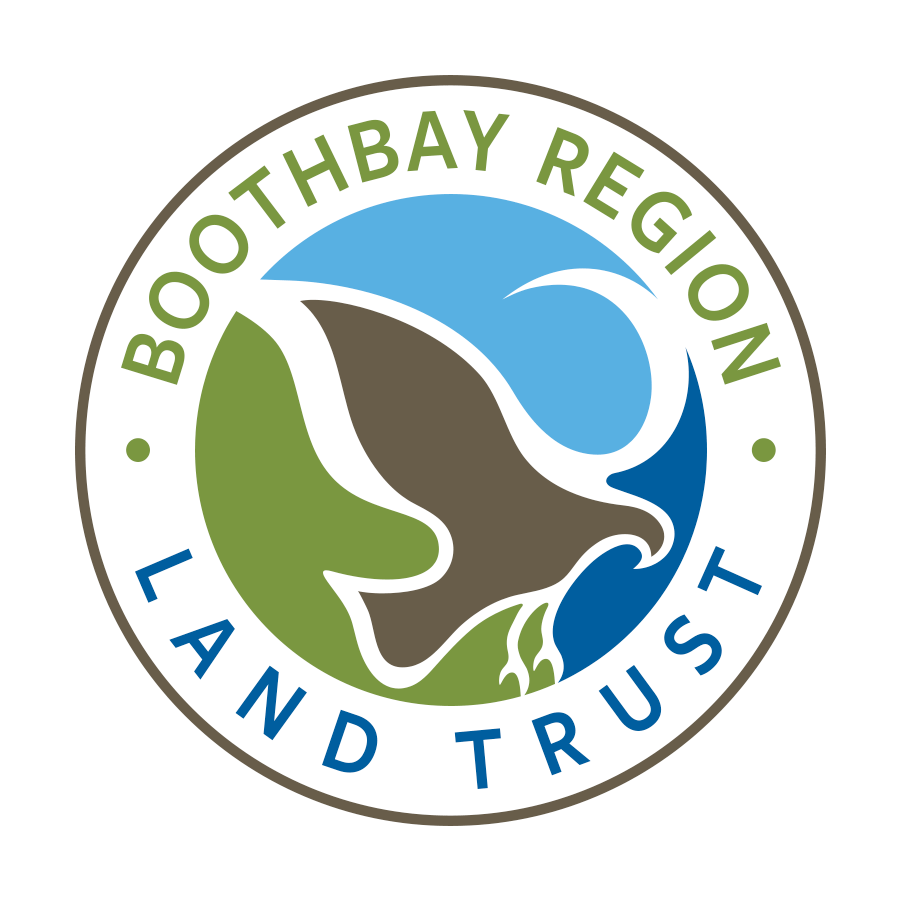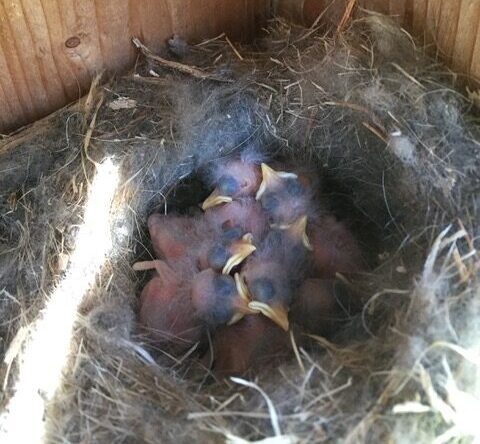Volunteer and long-time birder, Stan Wakefield, shares regular updates and pictures on bird nesting activity at BRLT’s bird boxes monitored at Oak Point Farm, Singing Meadows, Lobster Cove Meadow, Penny Lake, and Zak preserves. Data is also reported to NestWatch, a citizen-science monitoring program developed by the Cornell Lab of Ornithology and used nationwide to track the status and trends in the reproductive biology of birds. We encourage readers to check back frequently from April-August to keep up on all of the changes throughout the season.
(Review last year’s nesting activity here)
——————————————————————————————————————-
August 13:
The 2023 bird breeding season (for 18 monitored nest boxes on 5 Land Trust preserves) has been completed. All things considered it was an average year for house wrens, a pretty good year for tree swallows, and another very good year for eastern bluebirds. Seventeen of the 18 nest boxes were utilized at least once while nine of those 17 were used twice (by bluebirds). By far bluebirds used the nest boxes more than any other species, nesting twenty times this season. Tree swallows followed with five nesting efforts, and a house wren used one nest box. The high usage rate for bluebirds results from this species nesting twice per season versus just once for tree swallows.
The numbers for this year are as follows: one house wren nesting effort resulted in 5 eggs and 5 fledglings at Penny Lake. Tree swallows nested five times (once at Penny Lake, twice at Oak Point Farm, once at Lobster Cove Meadow, and once at Singing Meadows for a total of 27 eggs and 20 fledglings. As you might expect, bluebirds (nesting at all five preserves) were the leaders in both categories again this year. Eighty-nine eggs resulted in 75 bluebird fledglings this year.
As is often the case, not every nesting attempt this season was successful. Three efforts to build a nest, incubate eggs, and fledge young resulted in failure (i.e. deposited eggs failed to hatch and/or young birds failed to thrive). This occurred in two bluebird nests and one tree swallow nest.
All of the data gathered from this season’s nesting efforts was reported to the Cornell University Lab of Ornithology under their NestWatch Program.
Finally, most of the above statistics were gathered at three preserves twice per week over the season by several very dedicated volunteers who braved heat and/or rain to help me stay on top of this project. My sincere thanks go out to Carolyn Lanigan, Mike & Cheryl Lorrain, and Tina Bauer for their herculean efforts and excellent reporting.
Monitored bird breeding activity on five Land Trust preserves is, once again, nearing its seasonal end. As of today there are but three active nest boxes on two preserves. Zak preserve has one nest box with four young Bluebirds just itching to get out and test their wings. Penny Lake has two active nest boxes, one with four energetic young Bluebirds ready to fly very soon and one with five fast-growing baby House Wrens. We expect the Zak and Penny Lake Bluebirds to fledge this week while the Penny Lake House Wrens are expected to fledge early next week.
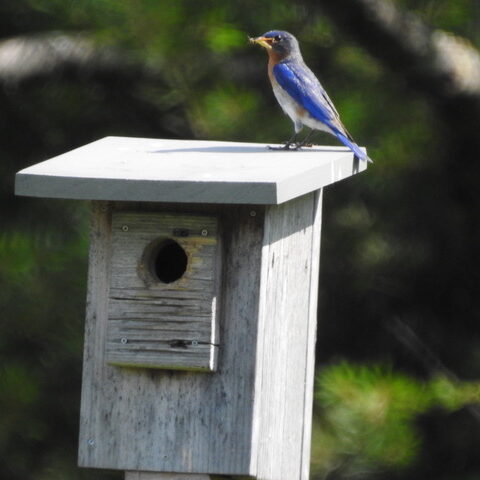
Male Bluebird with food for his brood at Penny Lake
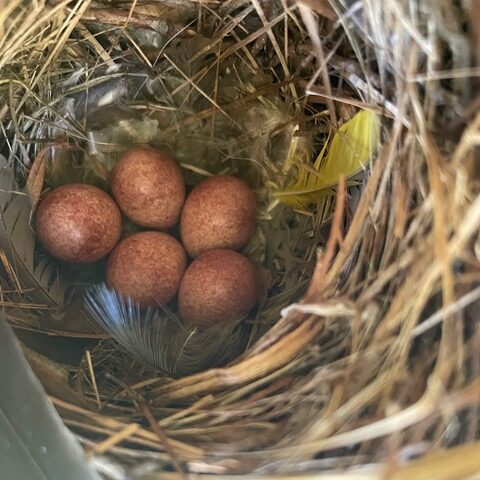
House wren eggs at Penny Lake
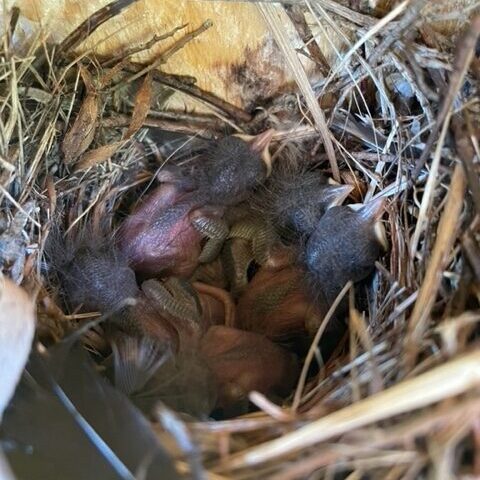
Recently-hatched baby House Wrens at Penny Lake
We’ve seen strong, albeit circumstantial, evidence that Bobolinks nested this year at Singing Meadows. Multiple male & female Bobolinks were seen frequently in the fields during regular nest box inspections throughout July. Their highly agitated behavior while observers were walking on the trails strongly suggested they were protecting one or more nest sites in the immediate vicinity. Since they nest in the tall, weedy fields it is not possible to locate and monitor their nests, nor would we want to try since doing so could easily disturb them and possibly cause them to abandon their nests. Although they have been seen on occasion in two previous years, we are not certain they have nested at Singing Meadows before; however these observations are an encouraging sign of future nesting activity by Bobolinks.
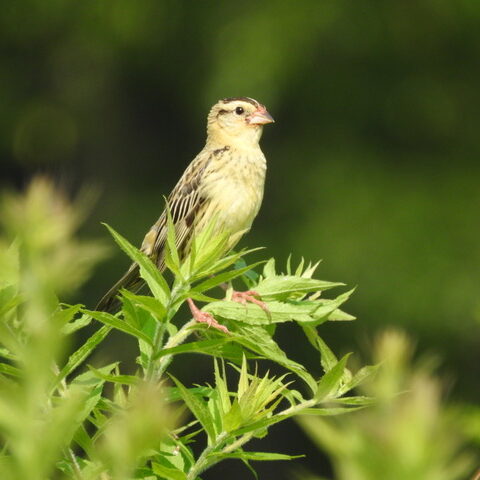
Female Bobolink at Singing Meadows
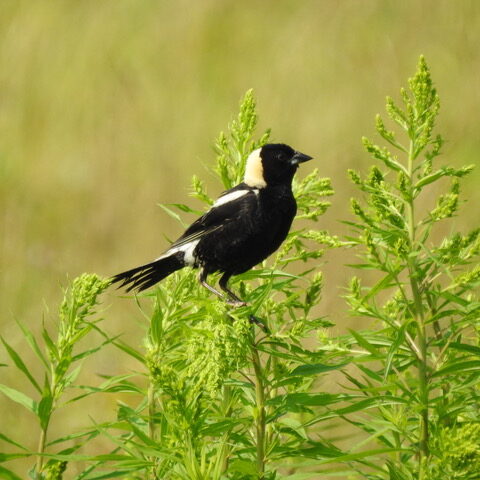
Male Bobolink at Singing Meadows

Bluebird eggs at Penny Lake
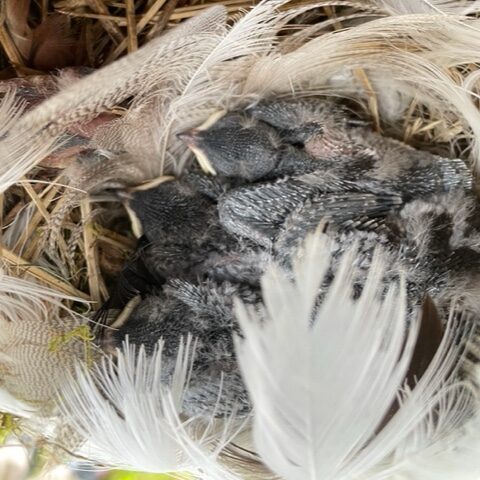
Young Tree Swallows at Oak Point Farm

A soon-to-fledge Bluebird at Zak Preserve
Unfortunately there have been a few disappointing nesting attempts this year. At least two Bluebird nests and two Tree Swallow nests failed to produce young for unknown reasons. Some eggs were abandoned and others failed to hatch due to infertility or predation. Even some young birds perished in their nests from unknown causes. These events occur every year and are simply a part of the cycle of life.
Some of the more interesting observations over the past couple of weeks include repeated sightings of Bobolinks at Singing Meadows and Zak preserves, which suggests this species is now breeding at these two locations. There have been several observations of adult birds feeding recently-fledged young birds away from their nests. A tiny Brown Creeper was observed feeding at least two of its offspring in the woodland at Oak Point Farm. A female Hairy Woodpecker and a White-breasted Nuthatch were seen feeding their respective young in trees around the Boothbay peninsula.
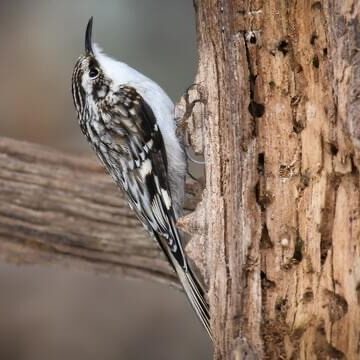
Brown creeper
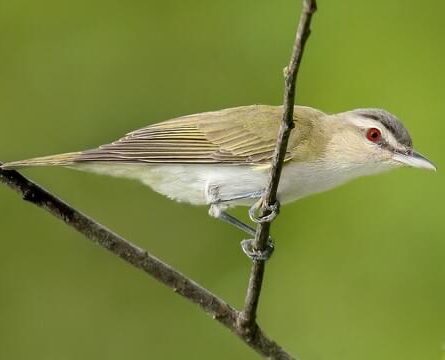
Red-eyed vireo
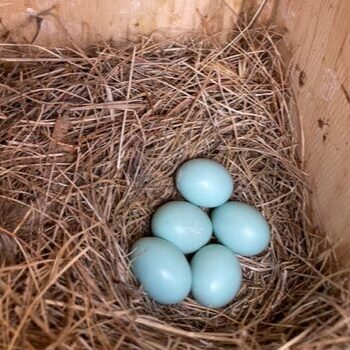
A second clutch of bluebird eggs at Singing Meadows

Male tree swallow with food for his offspring at Lobster Cove Meadow

Singing song sparrow at Oak Point
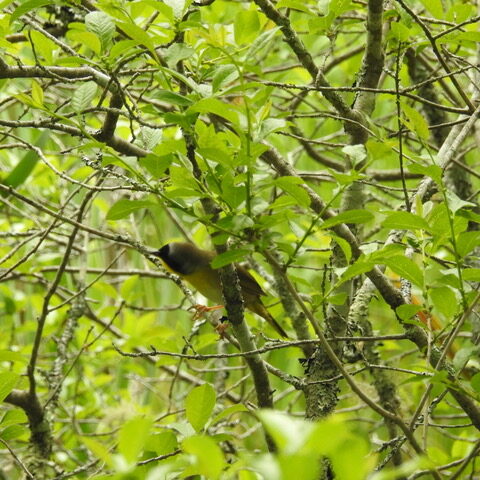
Common yellowthroat at Singing Meadows
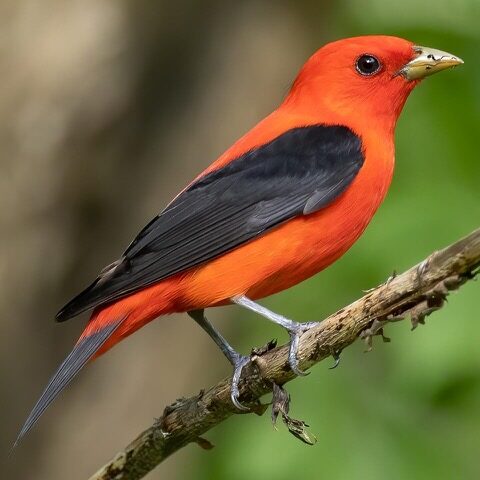
Male scarlet tanager

Female scarlet tanager
While late May/early June marks the declining period of the spring migration in Maine, the last week of May showed no signs of slowing down. The fields and woods were still full of the bird song of many species trying to claim breeding territory and attracting mates. Things should begin to quiet down a bit as we move further into June. Once breeding gets underway by these singing birds, they will stop singing so as to not attract the attention of potential predators to their nests.
Classic examples of persistent and frequent bird song on Land Trust preserves includes that of Baltimore Orioles, Great-crested Flycatchers, Yellow Warblers, Ovenbirds, American Redstarts, Black-throated Green Warblers, and Blackpoll Warblers (the latter a late migrant). Lobster Cove Meadow and Oak Point Farm, with extensive woodlands, seemed to be favorites of these and many other bird species.
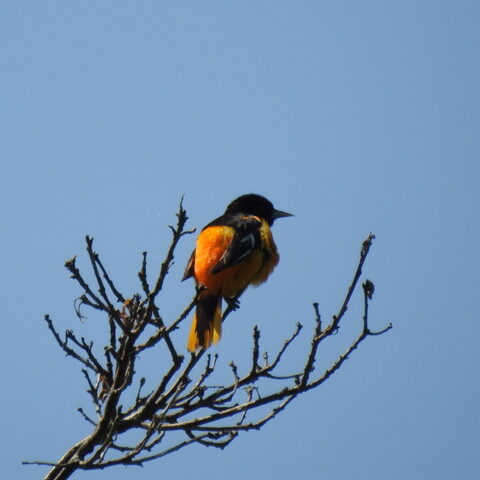
Baltimore Oriole at Lobster Cove Meadow
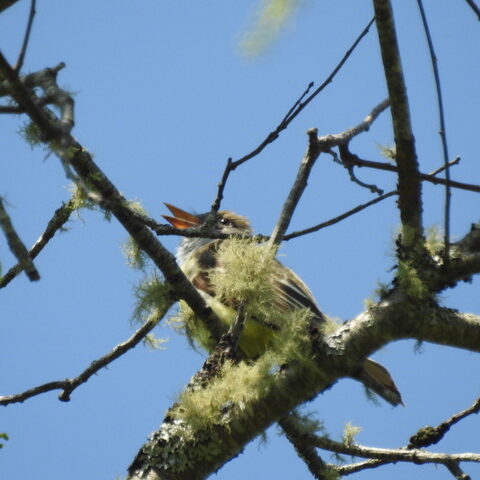
Great-crested Flycatcher at Lobster Cove Meadow
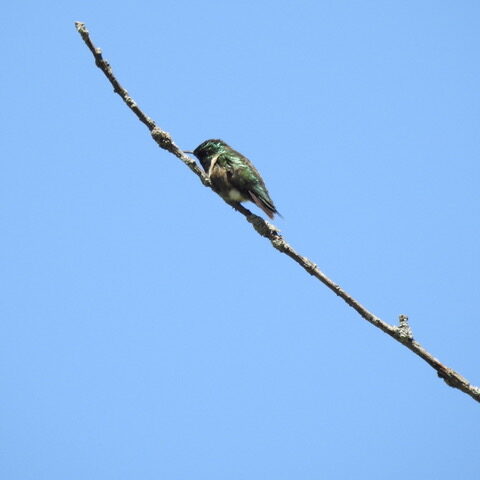
Ruby-throated hummingbird at Lobster Cove Meadow
Preserves such as Singing Meadows and Zak, with wide-open grassy meadows, attracted Bobolinks in particular. And for (possibly) the first time, a male Bobolink was seen (and heard) in a large grassy field at Oak Point.

Male Bobolink at Oak Point Farm
Bird breeding activity on five preserves with monitored nest boxes saw 22 young Eastern Bluebirds fledge in the past week and two of those nest boxes already has a second clutch of Bluebird eggs inside. As more first clutch Bluebird youngsters fledge, we expect to see more second clutches of Bluebird eggs. Many other monitored nest boxes contain the soon-to-hatch eggs of Tree Swallows.
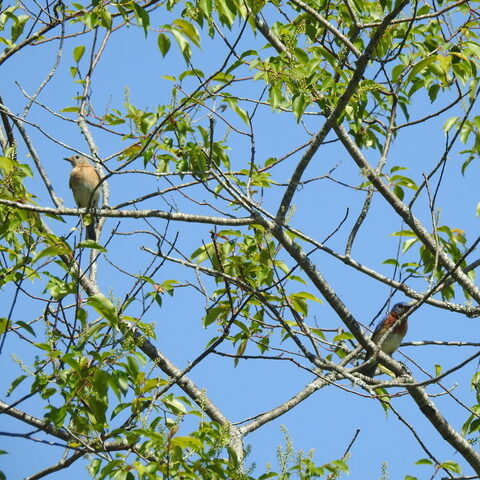
Male & female Bluebirds waiting for their youngsters to fledge at Penny Lake
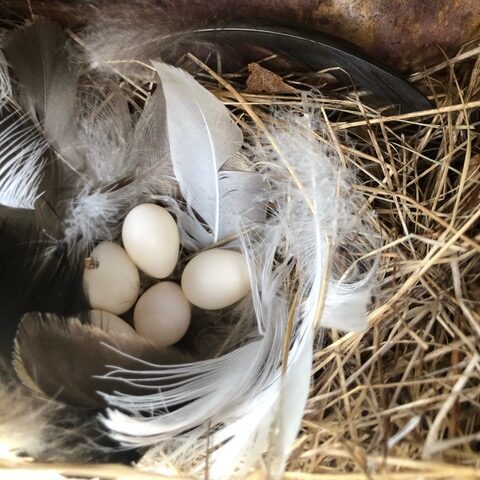
Tree swallow eggs at Singing Meadows
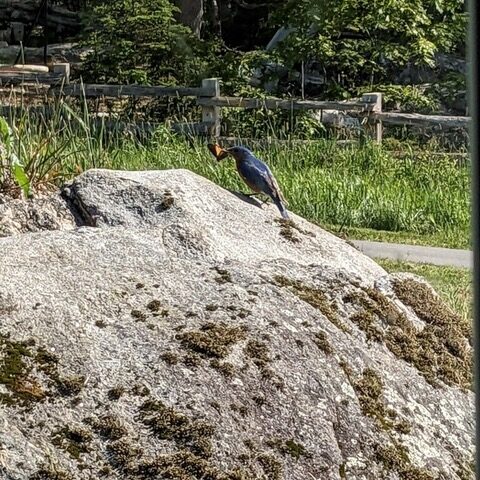
Male Bluebird with food for his youngsters at Oak Point Farm
It’s been another very “birdy” week on the Boothbay Region Land Trust preserves. At least 40 different bird species have been seen at one time or another this week on just five preserves. And it is likely that many more species have been active but unseen and unheard. We have already had several new young Bluebirds leave their nests at Oak Point Farm and many more will be leaving their nests this week at Singing Meadows, Zak, Penny Lake, and Lobster Cove Meadow. We have also had tree swallows start nesting in nest boxes on four of our five preserves. Canada geese have been rather prolific at Oak Point Farm and Lobster Cove Meadow — 17 fuzzy young goslings were seen with their parents on May 18th on the pond at Oak Point and up to 10 more were on the marsh at Lobster Cove Meadow.
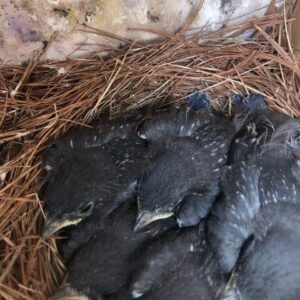
Young Bluebirds about to fledge at Singing Meadows
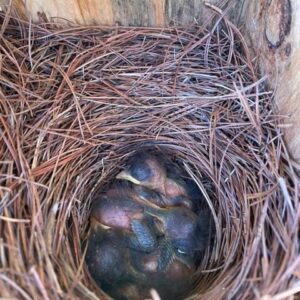
Baby Bluebirds at Oak Point Farm
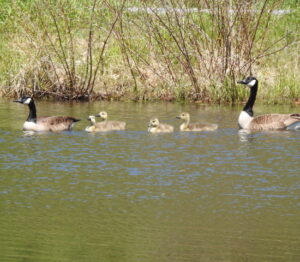
One of four Canada goose families at Oak Point Farm
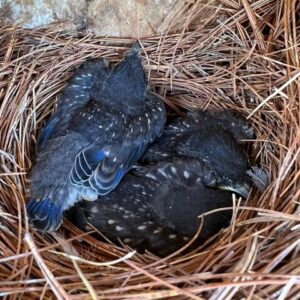
Young Bluebirds about to Fledge at Zak Preserve

Tree swallow egg in a feathery nest at Lobster Cove Meadow
Among the more interesting sightings this past week on the preserves were several species of warblers (Magnolia, black-throated green, black & white, pine, chestnut-sided, yellow, and parula), Baltimore orioles, bobolinks, a common raven, and four types of vireos (warbling, red-eyed, blue-headed, and Philadelphia). A majestic adult bald eagle was seen flying above Oak Point Farm when it was suddenly mobbed by several American crows and two broad-winged hawks were seen flying over Penny Lake.
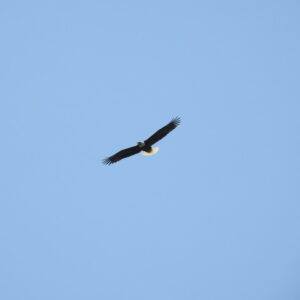
Bald eagle over Oak Point Farm

Broadwing hawk over Penny Lake Preserve
The rest of May should remain pretty active bird-wise as the spring migration winds down. By June, the woodlands will become much quieter as many of the spring migrants and local resident birds settle in to raise their families.

Ovenbird

Male Baltimore Oriole at Lobster Cove Meadow
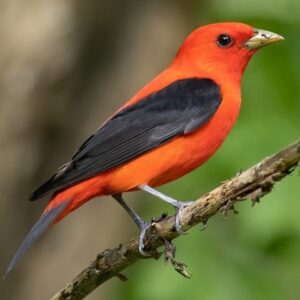
Scarlet Tanager
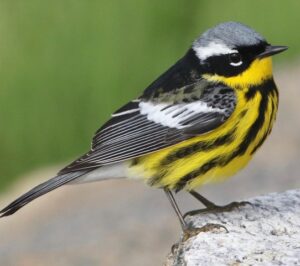
Magnolia warbler
While some of these birds will breed right here in Maine, many were part of a wave of migrants moving through our state on their way to breeding territories in Canada. The spring migration is peaking right about now, but will continue through the end of the month.
Ruby-throated hummingbirds are now being seen on a regular basis on the Boothbay peninsula. Males typically arrive before females and that is what is being seen now at nectar feeders. If you attract Hummingbirds with nectar feeders it is very important to keep the nectar fresh and the feeders clean.
The BRLT nest box monitoring program is now in high gear. The first young Bluebirds of the season are expected to fledge by this weekend at Singing Meadows. Many others will follow in the coming weeks. And that is just the first broods of the season. Most of the Bluebird adult pairs will start to raise a second brood about two weeks after the first fledglings leave the nest. As of today, the nest boxes on five Land Trust preserves contain 28 baby Bluebirds, 11 Bluebird eggs, 4 nesting Tree Swallows, and one nesting Black-capped Chickadee.
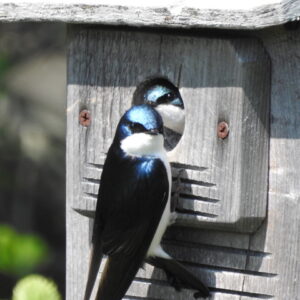
Tree swallows at Oak Point Farm
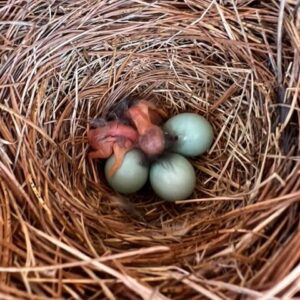
Hours-old Bluebird hatchlings at Zak preserve
Many more Bluebird eggs continue to be incubated at Lobster Cove Meadow (3), Penny Lake (4), Oak Point (3), Singing Meadows (10), and Zak (4). Many of these should be hatching within the coming week.
Penny Lake might have the first Tree Swallow nest of the season being built. A Tree Swallow was seen looking out from inside one of the nest boxes this past week.
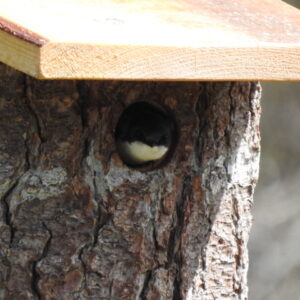
Tree Swallow at Penny Lake
There were two bird sightings of interest recently at Singing Meadows. The first was an American Kestrel, a small falcon, in flight over the meadow in classic Kestrel fashion (hovering) late last week. We installed a nest box designed for Kestrels at Singing Meadows two years ago so this could be a sign that a Kestrel may take up residence there. The second sighting of interest occurred today when two Broad-wing Hawks were seen flying over the preserve. These hawks have been returning to Maine over the past two weeks and their numbers far exceed those of all other raptors. As of today almost 2,000 Broad-wings have been observed and counted at the Bradbury Mountain Hawk Watch site so far this season.

Baby bluebirds at Singing Meadows
Five eggs being incubated in a nest box at Oak Point Farm may have hatched by today. The female Bluebird on this nest has been very attentive to her eggs during the past several inspections of this nest box, so much so that she refused to leave the nest during those inspections. We expect to see five little hatchlings on the next inspection.
Seven nest boxes on five Land Trust preserves currently contain incubating Bluebird eggs. We haven’t yet seen any nest building by other species (Tree Swallow, White-breasted Nuthatches, Black-capped Chickadees) but the season is still young.
The spring migration is about to ramp up dramatically. Several Warbler species (Pine, Black-Throated Green, and Yellow-Rumped) are being seen with some regularity and many others (Yellow, Chestnut-sided, Palm, Blackpoll, Bay-breasted, Canada, and Black-and-White) should be coming into view in the next few days. Hermit Thrushes are being heard in woodlands while Savannah & Swamp Sparrows are calling in their respective habitats.
Noteworthy sightings over the past week include a pair of Red Crossbills (in my front yard!), Broadwing Hawks (Lobster Cove Meadow), Canada Geese w/6 Goslings (Oak Point Farm), and nesting Ospreys (West Harbor causeway).
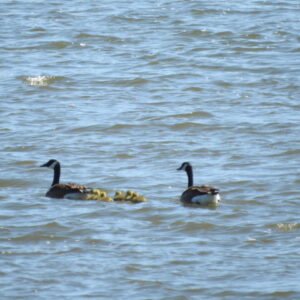
Canada geese with goslings at Oak Point Farm
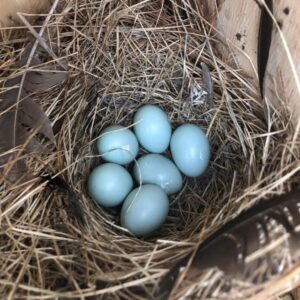
Clutch of bluebird eggs at Singing Meadows
Oak Point Farm, with the first batch of eggs this season, is expected to see five new hatchlings sometime this week while the other preserves are at least a week behind in this area. We’re hopeful this unseasonably chilly weather will improve to enable the adult Blues to find enough food for those new youngsters.
While the spring migration is still a week or so away from really ramping up, a few species have already returned to Maine in significant numbers. Last week the raptor spotters on Bradbury Mountain observed over 1,000 Broadwing Hawks fly over in just a few days. As of today over 1,300 Broadwings have been seen. Other raptors seen in good numbers so far include American Kestrels & Ospreys (over 200 each) and over 160 Sharp-shinned Hawks.
Speaking of Ospreys, which are now being seen in the Boothbay area frequently, a pair has returned to the site of a nest on the West Harbor Pond causeway. The original nest used by the birds was removed and a specially designed nesting platform was installed in its place in March by Central Maine Power in an effort to keep the birds from coming into contact with nearby power lines. Last week the Ospreys were seen rebuilding their nest on the new platform so it seems likely that they will be raising another pair of youngsters this summer.
We’ve already seen a few reports of Ruby-throated Hummingbirds in a couple of locations in Maine, so if you’re inclined to put out nectar feeders for these flying gems, now would be a good time to get them cleaned and filled with sugar water. Recall the nectar formula is 1 part granulated sugar to 4 parts water. These tiny birds will need to refuel during their long return journey from way down south and nectar feeders can be critical to their health before the flowers they need start to bloom.
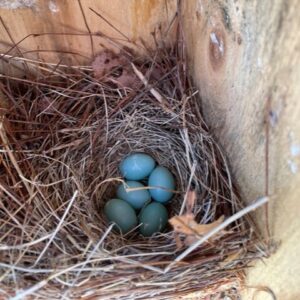
Bluebird eggs at Oak Point Farm
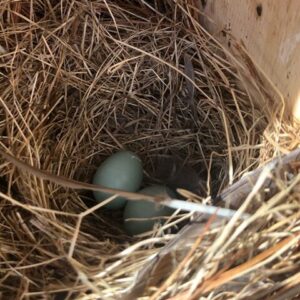
Bluebird eggs at Singing Meadows
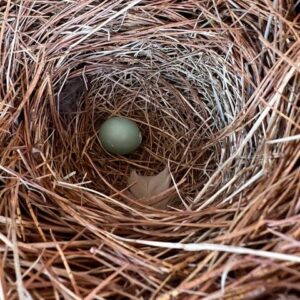
The first Bluebird egg at Zak preserve
Nests have been built or started in boxes at Lobster Cove Meadow and Penny Lake preserves, but no eggs have been seen yet. That is likely to change very soon.
Two pair of Canada geese are possibly incubating eggs at two locations in the freshwater marsh at Lobster Cove. They can be hard to see since they blend in with the marsh grasses very well.
A stroll around any of the Land Trust preserves will reveal a good start to the spring migration. Recent sightings of returning migrants include broad-winged hawks, kingfishers, ospreys, tree swallows and phoebes. Song sparrows are quite vocal just about everywhere. Many more seasonal migrants will be passing through in the coming weeks on their way to breeding grounds in Maine and Canada.
